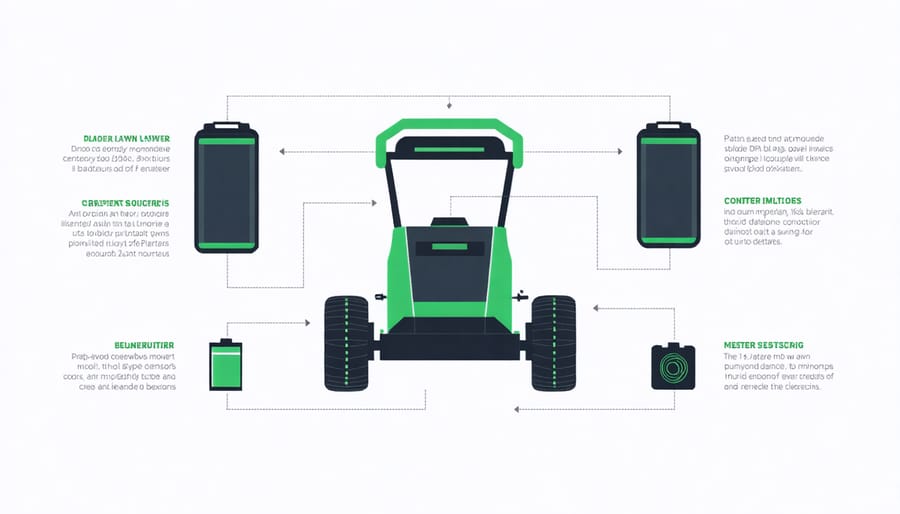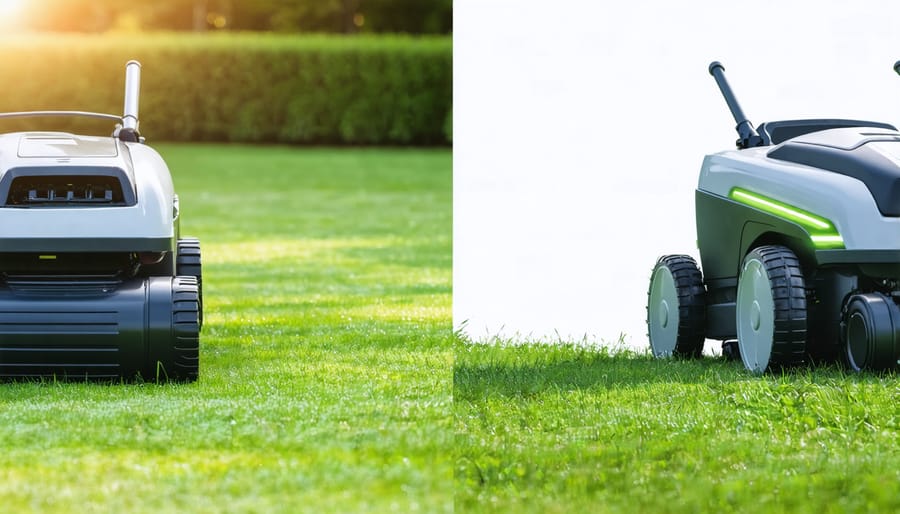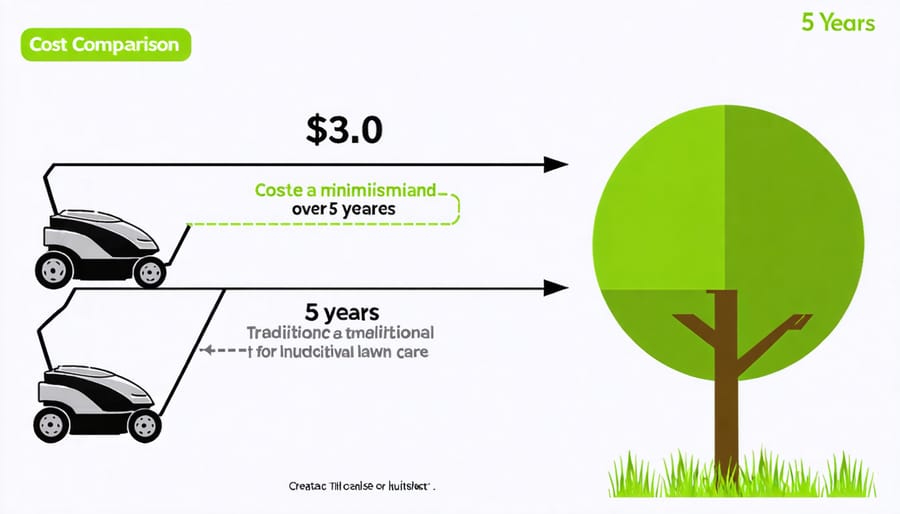Expect your robotic lawn mower to operate reliably for 7-10 years with proper maintenance and care. These innovative machines, when paired with effective robotic lawn mower scheduling, have revolutionized lawn maintenance by offering consistent, automated cutting without the physical strain of traditional mowing.
The actual lifespan depends heavily on three key factors: usage frequency (typically 2-3 hours daily during growing season), maintenance routine (blade replacement every 2-3 months, battery care), and environmental conditions (terrain type, weather exposure). While the initial investment might seem substantial—ranging from $800 to $3,500—the long-term value becomes apparent when considering the eliminated costs of traditional lawn care services or maintaining a conventional mower.
Think of robotic mowers like any other household appliance: with regular care and timely repairs, they’ll serve your lawn care needs throughout their expected lifespan, quietly maintaining your yard while you focus on other activities. Understanding these longevity factors helps make an informed decision about whether this smart gardening investment aligns with your lawn care goals.
Average Lifespan of Robotic Lawn Mowers
Expected Years of Service
Most robotic lawn mowers can last between 5 to 10 years with proper maintenance and care. Premium brands like Husqvarna and WORX typically offer models that serve reliably for 7-10 years, while budget-friendly options might have a shorter lifespan of 4-6 years.
Your usage patterns significantly impact longevity. Mowers running daily on larger lawns (over 1/2 acre) may show wear faster than those used 2-3 times weekly on smaller yards. Climate also plays a role – robots operating in harsh conditions or extreme temperatures might need replacement sooner.
Here’s what you can typically expect:
– Premium models (Husqvarna, WORX, Robomow): 7-10 years
– Mid-range models (Gardena, Honda): 5-8 years
– Budget models: 4-6 years
Keep in mind that individual components have different lifespans. Batteries usually need replacement every 3-4 years, while cutting blades require changing every 6-12 months depending on usage. The motor and chassis often last the full lifetime of the mower when properly maintained.
Remember that these are average estimates – your actual experience may vary based on maintenance habits, lawn conditions, and usage frequency.
Key Components and Their Durability
A robotic lawn mower’s lifespan largely depends on the durability of its key components. The cutting blades typically need replacement every 2-3 months, depending on your lawn size and mowing frequency. While this might seem frequent, blade replacement is inexpensive and easy to do yourself.
The battery, usually lithium-ion, generally lasts 2-3 years before showing significant capacity decline. Many users report getting up to 4 years of reliable performance before needing a replacement. The charging station contacts can last the entire lifetime of the mower but may need occasional cleaning to maintain good connectivity.
The wheels and motor components are built to withstand regular use and typically last 5-7 years with proper maintenance. The outer shell and protective housing usually remain intact throughout the mower’s lifetime unless damaged by accidents or extreme weather conditions.
Electronic components, including sensors and navigation systems, are well-protected and rarely fail when properly maintained. However, they can be the most expensive to replace if problems do occur. The motherboard and control systems typically last the full lifetime of the unit when protected from moisture and extreme temperatures.

Factors That Impact Robotic Mower Longevity
Yard Size and Terrain Type
The terrain and size of your lawn significantly impact your robotic mower’s lifespan. While these machines are designed to handle various conditions, challenging landscapes can put extra strain on their components. Understanding your lawn’s yard size capabilities is crucial for maximizing your mower’s longevity.
Flat, even terrains are gentler on robotic mowers, typically allowing them to operate efficiently for longer periods. However, yards with steep slopes, numerous obstacles, or rough terrain can accelerate wear and tear on wheels, motors, and cutting systems. Sandy soils might cause more friction on moving parts, while clay-heavy grounds can create additional resistance during wet conditions.
The size of your yard also matters. A robotic mower working at full capacity on a large property will naturally experience more wear than one maintaining a smaller space. For optimal performance and longevity, it’s essential to choose a model rated for your specific yard size and terrain type, giving your mower some breathing room rather than pushing it to its limits constantly.
Maintenance and Care Practices
Regular maintenance is crucial for maximizing your robotic lawn mower’s lifespan. Think of it like caring for your car – the better you maintain it, the longer it’ll serve you reliably. Start with weekly blade checks and cleaning; sharp, clean blades not only give you a better cut but also reduce strain on the motor. Clean the undercarriage after every few mowing sessions to prevent grass buildup, which can affect performance and cause unnecessary wear.
Battery care is especially important. Keep the charging station clean and protected from the elements, and make sure your mower can dock properly. During winter storage, maintain the battery at about 50% charge and store it in a cool, dry place – this simple step can significantly extend battery life.
Replace worn parts promptly, including blades, wheels, and brushes. Most manufacturers recommend blade replacement every 2-3 months during the mowing season. Keep an eye on the charging contacts and clean them regularly with a soft brush to ensure efficient charging.
Professional servicing once a year, preferably before the mowing season begins, can catch potential issues early. This typically includes a thorough inspection of electronic components, motor performance, and safety features. Following these maintenance practices can easily add 2-3 years to your robotic mower’s life expectancy.
Weather and Storage Conditions
Weather and storage conditions play a crucial role in determining how long your robotic lawn mower will last. These smart machines are designed to handle various weather conditions, but proper care during extreme weather can significantly extend their lifespan.
Most robotic mowers are built with weather-resistant materials and can handle light rain. However, prolonged exposure to heavy rainfall, extreme heat, or freezing temperatures can impact their performance and durability. During summer, try to schedule mowing during cooler parts of the day to prevent overheating of sensitive electronic components.
When winter approaches, it’s essential to store your robotic mower properly. Clean it thoroughly, remove the battery if possible, and keep it in a dry, temperature-controlled environment. A garage or garden shed works well, but ensure the storage space isn’t prone to dampness or extreme temperature fluctuations.
Salt air in coastal areas can be particularly harsh on electronic equipment and metal components. If you live near the coast, consider giving your mower extra protection and more frequent cleaning to prevent corrosion. Remember, proper storage and weather protection can add years to your mower’s life.
Maximizing Your Robot Mower’s Lifespan
Essential Maintenance Schedule
To keep your robotic lawn mower running smoothly and extend its lifespan, following a regular maintenance schedule is crucial. Like other robotic lawn maintenance tools, these mowers need consistent care to perform their best.
Weekly Maintenance:
• Clean the undercarriage and remove grass clippings
• Check and clean the wheels
• Inspect the cutting blades for damage
• Wipe down external sensors
• Empty the grass collection box (if equipped)
Monthly Tasks:
• Deep clean all components
• Test the charging station connections
• Check the perimeter wire for damage
• Lubricate moving parts as needed
• Update software if available
Seasonal Care (Spring/Fall):
• Replace cutting blades
• Clean or replace air filters
• Check battery health
• Inspect and tighten all screws
• Test safety features
Annual Maintenance:
• Professional inspection recommended
• Battery capacity test
• Complete system diagnostic
• Replacement of worn components
• Boundary wire check and repair
Remember to always consult your owner’s manual for model-specific maintenance requirements. Following this schedule diligently can help your robotic mower last 8-10 years or more. Keep a maintenance log to track service dates and replacement parts, making it easier to stay on top of your mower’s care routine.

Common Issues and Solutions
Even the most reliable robotic mowers can encounter issues, but most common problems have straightforward solutions that can help extend your mower’s lifespan. Here’s what to watch for and how to address these challenges:
Battery performance issues are among the most frequent concerns. If you notice reduced runtime, try implementing a regular charging schedule and avoid completely draining the battery. During winter storage, charge the battery every few months to maintain its health.
Navigation problems can occur when boundary wires get damaged or displaced. Regularly inspect the perimeter wire for breaks and ensure it’s properly secured. If your mower seems confused about its path, clean its sensors and check for interference from nearby electronic devices.
Cutting quality issues often stem from dull or damaged blades. Plan to replace blades every 2-3 months during peak mowing season. Clean the cutting deck weekly to prevent grass buildup, which can strain the motor and reduce efficiency.
Motor problems typically show up as unusual noises or reduced power. Keep the motor clean and free from debris, and ensure your mower isn’t tackling grass that’s too tall or wet. For steep slopes, consider creating zones or adjusting the schedule to reduce strain on the motor.
When error messages appear, consult your manual first – many issues can be resolved by simply cleaning sensors or adjusting settings. For persistent problems, don’t hesitate to contact professional service, as early intervention can prevent more serious damage.
When to Replace vs. Repair
Making the decision between repairing or replacing your robotic lawn mower doesn’t have to be complicated. A good rule of thumb is to consider replacement when repair costs exceed 50% of a new mower’s price. If your robot mower is less than 3 years old and the repair cost is reasonable, fixing it usually makes more financial sense.
Pay attention to the nature of the problem. Battery replacement, wheel repairs, or blade changes are normal maintenance items that shouldn’t trigger a full replacement. However, if you’re dealing with motherboard issues, damaged charging stations, or multiple failing components, it might be time to shop for a new unit.
Consider your mower’s performance history too. If it’s requiring increasingly frequent repairs or struggling to maintain your lawn effectively, replacement might be the better option. Watch out for signs like decreased battery life, inconsistent cutting patterns, or difficulty navigating your yard – these could indicate your mower is reaching the end of its useful life.
The age of your model is another important factor. Newer models often come with improved features and better energy efficiency, which could offset the cost of replacement over time. If your mower is over 5 years old and facing significant issues, upgrading to a newer model might provide better value in the long run.
Remember to factor in warranty coverage. If your mower is still under warranty, repairs might be covered, making it a clear choice to fix rather than replace.
Return on Investment Analysis
When considering a robotic lawn mower, it’s essential to perform a thorough cost-benefit analysis to understand the true value of your investment. While the initial purchase price of $800-$3,000 might seem steep, let’s break down the numbers over time.
A traditional lawn service typically costs between $30-$50 per week during the growing season (approximately 30 weeks), adding up to $900-$1,500 annually. Over five years, that’s $4,500-$7,500 in lawn care expenses. Even if you mow your own lawn, factor in the cost of a quality gas mower ($300-$600), annual maintenance ($100), fuel ($120/year), and your valuable time (2-3 hours weekly).
In comparison, a robotic mower’s running costs are minimal. You’ll spend about $50 annually on electricity and $150-$200 on maintenance over three years (including blade replacements and basic servicing). Even with the highest initial investment of $3,000, the total five-year cost would be approximately $3,500.
The math becomes even more favorable when you consider that many robotic mowers last 8-10 years with proper care. This means your investment could pay for itself within 2-4 years, depending on your current lawn care expenses. Plus, you’ll enjoy the convenience of a consistently maintained lawn without the weekly time commitment.
Remember that beyond the financial return, you’re also investing in convenience, consistent lawn care, and environmental benefits through reduced emissions and noise pollution. These factors, while harder to quantify, add significant value to your investment.

Robotic lawn mowers can be a fantastic investment for homeowners looking to simplify their lawn care routine, typically lasting between 5 to 10 years with proper maintenance. The key to maximizing your robot mower’s lifespan lies in regular upkeep, including blade replacement, battery care, and protecting it from harsh weather conditions.
Remember that while the initial cost might seem high, the long-term value becomes apparent when you consider the time saved and the consistent lawn maintenance these devices provide. To get the most out of your investment, stick to a regular maintenance schedule, keep spare parts on hand, and don’t hesitate to seek professional servicing when needed.
Whether your robotic mower lasts closer to 5 or 10 years largely depends on your lawn size, usage frequency, and how well you care for it. By following the maintenance guidelines we’ve discussed and choosing a high-quality model from a reputable manufacturer, you’ll be well-positioned to enjoy years of automated lawn care. Consider it a long-term investment in both your property’s appearance and your free time.
